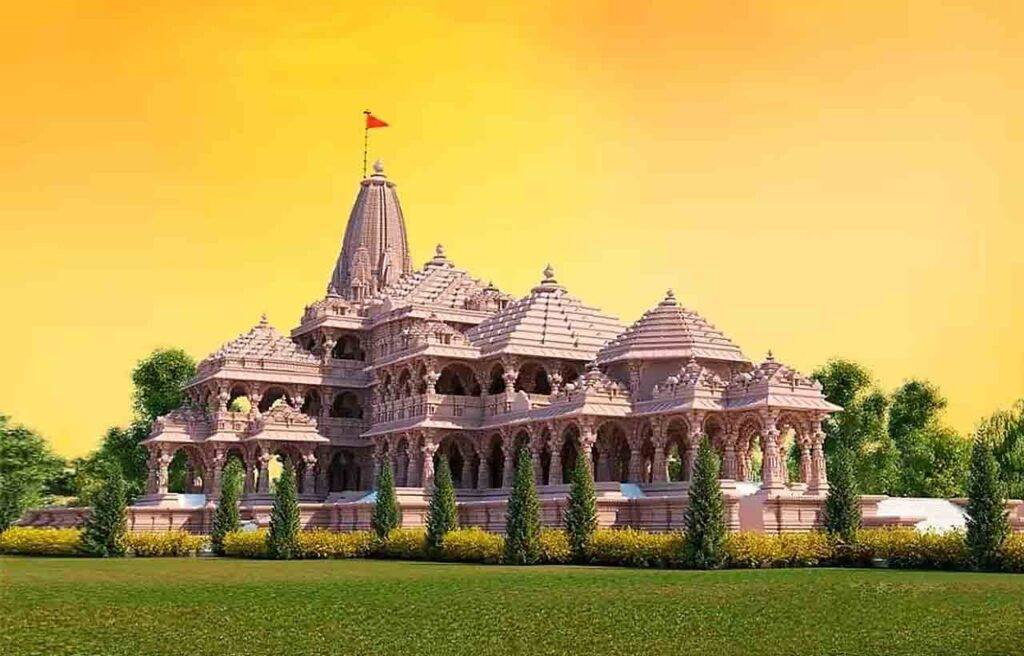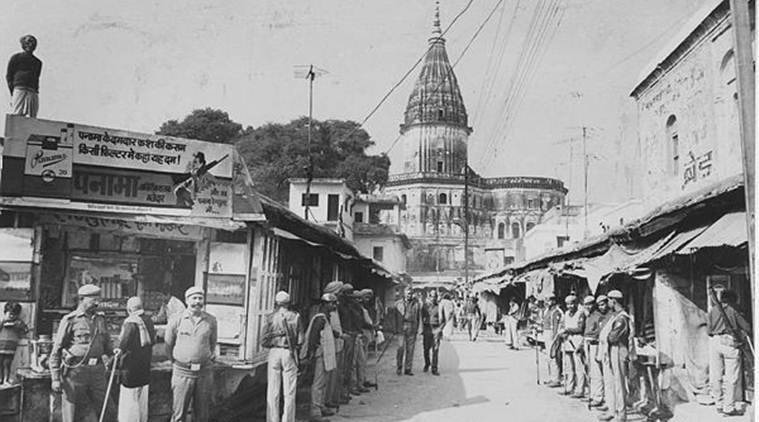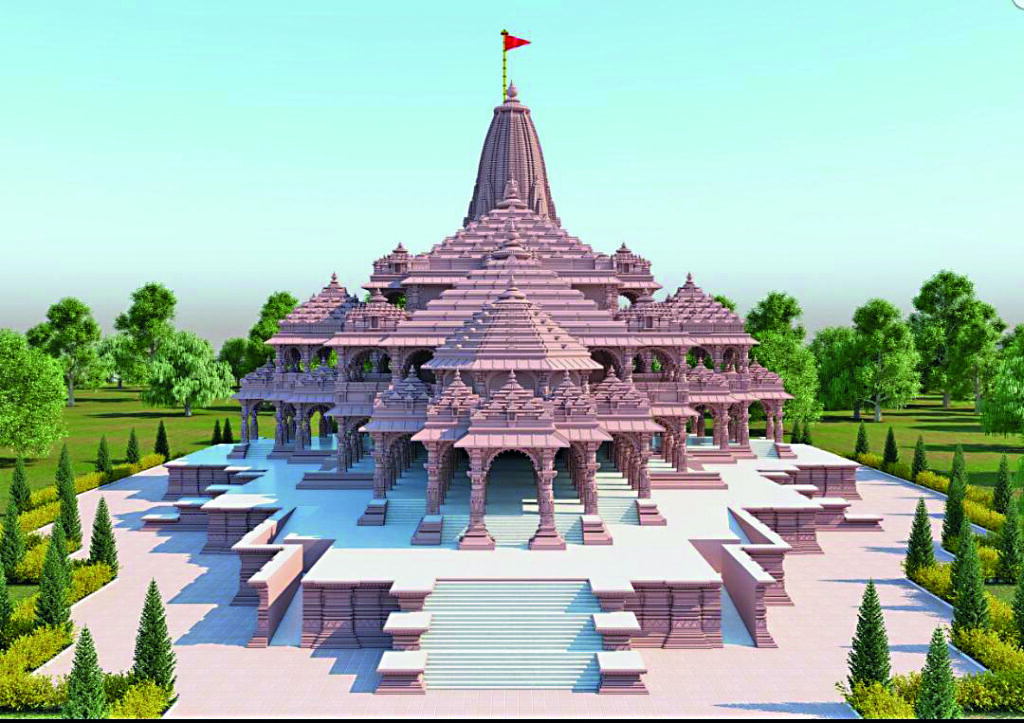
Ayodhya, a city in Uttar Pradesh, India, is considered to be one of the most sacred places for Hindus. It is believed to be the birthplace of Lord Ram, the seventh incarnation of Lord Vishnu, and the hero of the epic Ramayana. Ayodhya is also the site of a long-standing dispute over a piece of land where a mosque, known as Babri Masjid, was built in the 16th century by the Mughal emperor Babur. The mosque was demolished by Hindu activists in 1992, sparking communal riots and legal battles. In 2019, the Supreme Court of India ruled in favor of building a Ram mandir at the disputed site, paving the way for the construction of a grand temple that is expected to be completed in 2024.
In this blog, we will explore the history of the Ram Mandir, its architecture, its significance, and how to visit it.
History of the Ram Mandir
The history of the Ram Mandir in Ayodhya is centuries old and shrouded in myths and legends. According to the Ramayana, Ayodhya was the capital of the kingdom of Kosala, ruled by King Dasharatha, the father of Lord Ram. Ram was born in Ayodhya and spent his childhood and youth there. He was exiled for 14 years by his stepmother Kaikeyi, who wanted her son Bharat to be the king. Ram, along with his wife Sita and brother Lakshman, left Ayodhya and lived in the forests, where he fought many demons and faced many challenges. He also rescued Sita from the demon king Ravana, who had abducted her and taken her to Lanka. After completing his exile, Ram returned to Ayodhya and was crowned as the king. He ruled for many years and established an ideal society, known as Ram Rajya.
The exact location of Ram’s birthplace in Ayodhya is a matter of debate and controversy. Some believe that it is the site where the Babri Masjid stood, while others claim that it is somewhere else in the vicinity. According to some historical records, a temple dedicated to Ram existed at the site before the Mughal invasion. The temple was allegedly demolished by Babur’s general Mir Baqi in 1528 and a mosque was built in its place. The mosque was named after Babur Babri Masjid. The mosque became a bone of contention between Hindus and Muslims, who both claimed the site as their own. The first recorded dispute over the site occurred in 1853, when a group of Hindu ascetics, known as Nirmohis, clashed with the Muslims over the possession of the site. The British colonial administration intervened and erected a fence to divide the site into two parts: the inner courtyard for the Muslims and the outer courtyard for the Hindus. The Hindus erected a platform, called Ramchabutra, outside the mosque, where they worshipped the idol of Ram. In 1885, a Hindu priest named Mahant Raghubir Das filed a lawsuit to build a temple on the Ramchabutra, but his plea was rejected by the court.

The dispute over the site intensified in the 20th century, especially after the independence of India in 1947. In 1949, a group of Hindu activists secretly placed idols of Ram and Sita inside the mosque, claiming that they had miraculously appeared there. The government locked the mosque and declared it a disputed site, but allowed the Hindu priests to perform daily rituals for the idols. In 1950, a Hindu devotee named Gopal Singh Visharad filed a lawsuit to seek permission to worship the idols inside the mosque. The same year, another Hindu plaintiff named Paramhans Ramchandra Das filed a lawsuit to claim ownership of the entire site and seek the removal of the mosque. In 1959, the Nirmohi Akhara, a Hindu religious sect, also filed a lawsuit to claim the management rights of the site. In 1961, the Sunni Central Waqf Board, a Muslim body, filed a lawsuit to declare the mosque as its property and seek the removal of the idols. These lawsuits were consolidated and transferred to the Allahabad High Court in 1989.
In the meantime, the political and religious mobilization around the issue of the Ram Mandir gained momentum in the 1980s and 1990s. Several Hindu nationalist groups, such as the Vishva Hindu Parishad (VHP), the Rashtriya Swayamsevak Sangh (RSS), and the Bharatiya Janata Party (BJP), launched a campaign to build a Ram mandir at the disputed site. They organized rallies, marches, and public meetings to garner support for their cause. They also collected bricks, stones, and donations from across the country to construct the temple. They claimed that the site was the undisputed birthplace of Ram and that the mosque was an insult to the Hindu faith. They also invoked the historical grievances of the Hindu community against the Muslim invaders and rulers, who had allegedly destroyed many Hindu temples and monuments. They demanded that the government hand over the site to the Hindus or enact a law to facilitate the construction of the temple.
The campaign reached its climax on December 6, 1992, when a large crowd of Hindu activists, led by some BJP leaders, gathered at the site to perform a symbolic ceremony for the temple. The crowd soon turned violent and stormed the mosque, demolishing it with axes, hammers, and crowbars. The demolition of the Babri Masjid triggered widespread communal riots across the country, killing more than 2,000 people and injuring many more. The riots also sparked off a series of terrorist attacks, such as the 1993 Mumbai bombings, that targeted Hindu and Muslim communities. The demolition also had a significant impact on Indian politics, as the BJP emerged as a major political force, while the Congress party lost its popularity. The demolition also strained the relations between India and its neighboring countries, such as Pakistan and Bangladesh, which have large Muslim populations.
The demolition of the Babri Masjid also led to a prolonged legal battle over the ownership and status of the disputed site. In 1993, the central government acquired the entire site and the surrounding land and referred the matter to the Supreme Court. The Supreme Court directed the government to maintain the status quo and ordered a stay on all religious activities at the site, except the daily rituals for the idols. The Supreme Court also asked the Allahabad High Court to expedite the hearing of the pending lawsuits and deliver a verdict on the title suit. In 2003, the Archaeological Survey of India (ASI) conducted an excavation at the site on the orders of the Allahabad High Court. The ASI submitted a report stating that it had found evidence of a large structure beneath the mosque, which could be a Hindu temple. However, the report was contested by some historians and archaeologists, who questioned its methodology and conclusions.
In 2010, the Allahabad High Court delivered its verdict on the title suit, dividing the disputed site into three parts: one-third to Ram Lalla, the idol of the infant Ram, represented by the Hindu Mahasabha; one-third to the Nirmohi Akhara; and one-third to the Sunni Waqf Board. The court also ruled that the site was the birthplace of Ram and that the mosque was built after demolishing a Hindu temple. However, the verdict was challenged by all the parties in the Supreme Court, which stayed the order and began hearing the appeals in 2018. In 2019, the Supreme Court delivered its final and unanimous verdict on the case, granting the entire site to Ram Lalla and paving the way for the construction of a Ram mandir. The court also ordered the government to provide an alternative site of five acres to the Sunni Waqf Board to build a mosque. The court based its judgment on the historical, archaeological, and legal evidence, as well as the principles of justice, equity, and good conscience. The court also appealed to the people of India to maintain peace and harmony and respect the verdict.
Architecture of the Ram Mandir
The Ram mandir in Ayodhya is being built by the Shri Ram Janmabhoomi Teerth Kshetra, a trust set up by the central government in 2020 to oversee the construction and management of the temple. The trust has appointed the VHP’s Ram Janmabhoomi Nyas, a committee formed in 1985 to spearhead the temple movement, as the main executor of the project. The trust has also engaged the Sompura family, a lineage of temple architects from Gujarat, to design and construct the temple. The Sompuras have designed and built more than 200 temples across India and abroad, including the Swaminarayan temples in Delhi and London.

The Ram Mandir in Ayodhya is being built according to the Nagara style of temple architecture, which is prevalent in North India. The temple will have a three-storeyed structure, with a height of 161 feet, a length of 270 feet, and a width of 140 feet. The temple will have a shikhara, or a spire, over the sanctum sanctorum, where the idol of Ram Lalla will be installed. The temple will also have five domes, representing the five brothers of Ram: Bharat, Lakshman, Shatrughan, and the twins Luv and Kush. The temple will have a total of 366 pillars, 212 on the ground floor, 86 on the first floor, and 68 on the second floor.
Significance of the Ram Mandir
The Ram Mandir in Ayodhya is not just a religious structure, but also a symbol of the cultural and spiritual heritage of India. The temple represents the faith and devotion of millions of Hindus, who revere Ram as their ideal king and role model. The temple also signifies the triumph of truth over falsehood, justice over injustice, and dharma over adharma, as exemplified by the life and deeds of Ram. The temple also reflects the diversity and unity of India, as people from different regions, languages, castes, and communities have contributed to its construction and development. The temple also aims to promote the values of peace, harmony, and brotherhood among all sections of the society, irrespective of their religious affiliations. The temple also hopes to boost the economy and tourism of Ayodhya and the surrounding areas, by creating employment opportunities and attracting visitors from across the world.
How to Visit the Ram Mandir in Ayodhya
The temple will have a capacity to accommodate 40,000 devotees at a time and will have facilities such as parking, toilets, drinking water, and security. The temple will also have a museum, a library, a research center, and a gallery, showcasing the history and culture of Ayodhya and Ramayana. The temple will also have a theme park, a garden, and a food court, offering a variety of cuisines and entertainment options. In this article, we will provide some tips and information on how to visit the Ram mandir and make the most of your trip.
How to Reach Ayodhya
Ayodhya is well connected by road, rail, and air to various parts of the country and the world. The nearest airport to Ayodhya is the Faizabad Airport, which is about 8 km away from the city. The airport has domestic flights to and from Delhi, Mumbai, Lucknow, and Varanasi. The nearest international airport to Ayodhya is the Chaudhary Charan Singh International Airport in Lucknow, which is about 134 km away from the city. The airport has flights to and from major cities in India and abroad, such as Dubai, Bangkok, Singapore, London, and New York. You can take a taxi, a bus, or a train from the airport to reach Ayodhya.

Ayodhya has two railway stations: the Ayodhya Junction and the Faizabad Junction. The Ayodhya Junction is about 2 km away from the Ram Janmabhoomi site, while the Faizabad Junction is about 6 km away. Both stations have trains to and from various cities in India, such as Delhi, Mumbai, Kolkata, Chennai, Hyderabad, Bangalore, and Ahmedabad. You can take a rickshaw, a taxi, or a bus from the railway station to reach the Ram mandir.
Ayodhya is also accessible by road from different parts of the country. The city is located on the National Highway 28, which connects Lucknow and Gorakhpur. The city is also connected by state highways to other cities in Uttar Pradesh, such as Varanasi, Allahabad, Kanpur, and Agra. You can take a bus, a car, or a bike to reach Ayodhya by road. There are many bus services, both government and private, that operate between Ayodhya and other cities. You can also hire a taxi or a cab from any nearby city to reach Ayodhya.
Where to Stay in Ayodhya
Ayodhya has a range of accommodation options to suit different budgets and preferences. You can choose from hotels, guest houses, lodges, ashrams, and dharamshalas to stay in Ayodhya. Some of the popular hotels in Ayodhya are:
- Ramprastha Hotel: This is a three-star hotel located near the Ram Janmabhoomi site. The hotel has 30 rooms, with amenities such as air conditioning, television, Wi-Fi, and attached bathrooms. The hotel also has a restaurant, a banquet hall, a conference room, and a parking facility. The room tariff ranges from Rs. 2,000 to Rs. 4,000 per night.
- Hotel Ramkatha: This is a budget hotel located near the Hanuman Garhi temple. The hotel has 20 rooms, with amenities such as air conditioning, television, and attached bathrooms. The hotel also has a restaurant, a terrace, and a parking facility. The room tariff ranges from Rs. 800 to Rs. 1,500 per night.
- Hotel Krishna Palace: This is a budget hotel located near the Saryu River. The hotel has 15 rooms, with amenities such as air conditioning, television, and attached bathrooms. The hotel also has a restaurant, a garden, and a parking facility. The room tariff ranges from Rs. 700 to Rs. 1,200 per night.
Some of the popular guest houses and lodges in Ayodhya are:
- Shri Ram Janaki Guest House: This is a guest house located near the Ram Janmabhoomi site. The guest house has 10 rooms, with amenities such as air conditioning, television, and attached bathrooms. The guest house also has a restaurant, a lounge, and a parking facility. The room tariff ranges from Rs. 500 to Rs. 1,000 per night.
- Shri Ram Bhawan: This is a lodge located near the Kanak Bhawan temple. The lodge has 12 rooms, with amenities such as air conditioning, television, and attached bathrooms. The lodge also has a restaurant, a hall, and a parking facility. The room tariff ranges from Rs. 400 to Rs. 800 per night.
- Shri Ram Darbar: This is a lodge located near the Nageshwar Nath temple. The lodge has 8 rooms, with amenities such as air conditioning, television, and attached bathrooms. The lodge also has a restaurant, a garden, and a parking facility. The room tariff ranges from Rs. 300 to Rs. 600 per night.
Some of the popular ashrams and dharamshalas in Ayodhya are:
- Shri Ram Janmabhoomi Nyas Dharamshala: This is a dharamshala run by Ram Janmabhoomi Nyas, the committee in charge of the temple construction. The dharamshala is located near the Ram Janmabhoomi site. The dharamshala has 50 rooms, with amenities such as air conditioning, television, and attached bathrooms. The dharamshala also has a dining hall, a library, and a parking facility. The room tariff is Rs. 200 per night.
- Shri Ram Janaki Dharamshala: This is a dharamshala run by the Shri Ram Janaki Trust, a charitable organization. The dharamshala is located near the Ram Janmabhoomi site. The dharamshala has 40 rooms, with amenities such as air conditioning, television, and attached bathrooms. The dharamshala also has a dining hall, a meditation hall, and a parking facility. The room tariff is Rs. 150 per night.
- Shri Ram Bhakti Ashram: This is an ashram run by the Shri Ram Bhakti Trust, a religious organization. The ashram is located near the Saryu River. The ashram has 30 rooms, with amenities such as air conditioning, television, and attached bathrooms. The ashram also has a dining hall, a prayer hall, and a parking facility. The room tariff is Rs. 100 per night.
What to See and Do in Ayodhya
Ayodhya is a city of temples, monuments, and festivals, that celebrate the life and legacy of Ram. There are many places to see and things to do in Ayodhya, such as:
- Ram Janmabhoomi: This is the most important and sacred site in Ayodhya, where the Ram Mandir is being built. The site is believed to be the birthplace of Ram and has been a center of worship and pilgrimage for Hindus for centuries. The site also has a makeshift temple, where the idols of Ram Lalla, Sita, and Lakshman are kept and worshipped. The site is open for darshan from 7 am to 11 am and from 3 pm to 6 pm. The entry is free, but you have to go through a security check and deposit your belongings at the locker facility. You can also offer donations and prayers at the site.
- Hanuman Garhi: This is a temple dedicated to Hanuman, the monkey god and the loyal devotee of Ram. The temple is located on a hill and has a flight of 76 steps leading to it. The temple has a statue of Hanuman, sitting in a reclining posture, holding a mountain in one hand and a mace in the other. The temple also has a shrine of Ram and Sita and a cave where Hanuman is said to have lived. The temple is open for darshan from 5 am to 10 pm. The entry is free, but you have to remove your shoes and cover your head before entering the temple. You can also offer prasad and flowers at the temple.
- Kanak Bhawan: This is a temple dedicated to Sita, the consort of Ram. The temple is also known as Sone ka Ghar, or the house of gold, because of its golden decorations and ornaments. The temple has a statue of Ram and Sita, adorned with gold and jewels, sitting on a throne. The temple also has a hall, where the wedding ceremony of Ram and Sita is depicted in paintings and sculptures. The temple is open for darshan from 8 am to 12 pm and from 4 pm to 8:30 pm. The entry is free, but you have to remove your shoes and cover your head before entering the temple. You can also offer prasad and flowers at the temple.
- Nageshwar Nath Temple: This is a temple dedicated to Lord Shiva, the destroyer and the transformer. The temple is one of the oldest temples in Ayodhya and is said to have been built by Kush, the son of Ram. The temple has a lingam, or a phallic symbol, representing Lord Shiva, and is surrounded by sculptures of various gods and goddesses. The temple is also famous for its annual fair, held during the festival of Shivaratri. The temple is open for darshan from 6 am to 8 pm. The entry is free, but you have to remove your shoes and cover your head before entering the temple. You can also offer milk, water, and flowers to the lingam.
These are some of the best places to visit in Ayodhya, but there are many more to explore and enjoy. You can also witness the colorful and vibrant festivals of Ayodhya, such as Ram Navami, Shravan Jhula, Diwali, and Ram Vivah. You can also taste the delicious and authentic cuisine of Ayodhya, such as kachori, jalebi, malpua, peda, and lassi. You can also shop for some souvenirs and handicrafts, such as idols, paintings, pottery, and jewelry, from the local markets and bazaars. Ayodhya is a city that will fill your heart with devotion, joy, and peace.

Hi, I’m Nathan Cross, a writer and avid reader who loves crafting articles for newspapers and online platforms. Words are my passion, whether I’m telling stories, sharing insights, or sparking conversations. When I’m not writing, you’ll find me lost in a book or out on the baseball field, enjoying the game that keeps me grounded. Writing, reading, and baseball—these are the things that define me.




